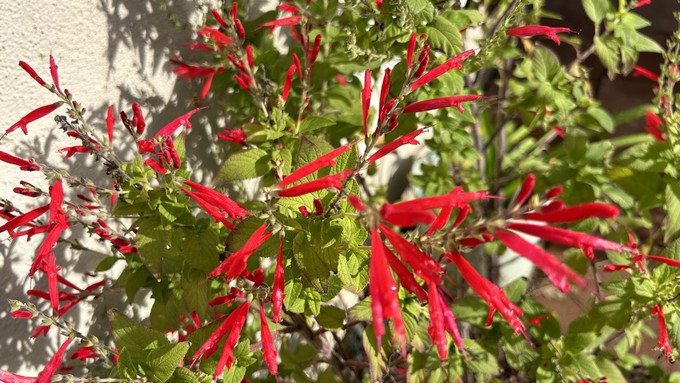
Food, flowers and shelter especially needed in winter

Pineapple sage produces gorgeous bright red tubular flowers much favored by hummingbirds. This plant grows next to a south-facing wall and is thriving even in winter. Kathy Morrison
The overwintering birds are back in my garden. The dark-eyed juncos and the white-crowned sparrows scritch in the mulch. The hummingbirds pause ever so briefly to sip nectar from the still-blooming pineapple sage. The lesser goldfinches flit into branches of the crape myrtle, checking the scene before they snack at the bird feeder, then take a quick drink from the birdbath.
Then one of the local jays arrives, landing like a jumbo jet and scaring them all off -- for a few minutes, at least.
It's easy to make even a small yard inviting for the local birds, who during winter might need some help staying safe and staying fed. Many trees have lost their leaves, and along with it the cover they provide. The usual food is gone, too: Most insects are dormant, and the caterpillars are gone until warmer weather.
So the birds seem to appreciate the shrubs, the leaf-scattered planting beds, the tubular flowers and the human-provided seeds, nuts and water.
Here are some suggestions for plants that support birds, especially in winter (and often pollinators and other wildlife during the rest of the year). Among them are native-plant recommendations from the National Audubon Society. Follow the links here to read more about the plants.
-- Blue elderberry, Sambucus mexicana. Elderberries provide a crucial source of food for birds in California; the blue variety is native to the Sacramento region.
-- Coffeeberry, Frangula california. The plant has small white flowers in summer that later turn into dark berries popular with birds.
-- Common manzanita, Arctostaphylos manzanita. Hummingbirds are attracted to the flowers, while other birds go for the fruits.
-- Common snowberry, Symphoricarpos albus. Attractive white berries give this native its common name.
-- Coyote bush (aka coyote brush), Baccharis pilularis. Lesser goldfinches are fond of the seeds.
-- Interior live oak, Quercus wislizeni. and scrub oak, Quercus berberidifolia. Native oaks are the "keystone" species for native wildlife, and they are also one of the easiest to grow. (Just ask the squirrels, who plant them regularly.) The acorns provide food, and the tree provides shelter.
-- Toyon, Heteromeles arbutifolia. The red berries are popular with mockingbirds, among others.
Unofficially, I've found that not only do the hummingbirds like the pineapple sage (Salvia elegans), they also frequently visit the red and white flowers of the "Hot Lips" salvia (Salvia microphylla). The lesser goldfinches have found the two frost-killed basil plants that I never pulled out, and they're enjoying the seeds that remain there. None of these is native, but they do add plant diversity to the garden and to the birds' food sources.
If you're intrigued by this topic, you should know that "habitat gardening" is the theme of the 2024 Sacramento Master Gardeners' Gardening Guide & Calendar, still available through the website here. (It will also be on sale at in-person winter events such as the Jan. 20 Open Garden at the Fair Oaks Horticulture Center.) The publication is packed with valuable information on supporting wildlife through plantings.
My 2022 post on becoming a birdwatcher can be found here.
Comments
0 comments have been posted.Sacramento Digs Gardening to your inbox.
Food in My Back Yard Series
April 1: Don't be fooled by these garden myths
March 25: Fertilizer tips: How to 'feed' your vegetables for healthy growth
March 18: Time to give vegetable seedlings some more space
March 11: Ways to win the fight against weeds
March 4: Potatoes from the garden
Feb. 25: Plant a fruit tree now -- for later
Feb. 18: How to squeeze more food into less space
Feb. 11: When to plant? Consider staggering your transplants
Feb. 4: Starting in seed starting
Sites We Like
Garden Checklist for week of March 30
Your garden doesn’t mind April showers. Get busy now to enjoy those future flowers.
* Get ready to swing into action in the vegetable garden. As nights warm up over 50 degrees, start setting out tomato, pepper and eggplant transplants.
* From seed, plant beans, beets, cantaloupes, carrots, corn, cucumbers, melons, pumpkins, radishes and squash. (Soak beet seeds overnight in water for better germination,)
* Plant onion sets.
* In the flower garden, plant seeds for asters, cosmos, celosia, marigolds, salvia, sunflowers and zinnias.
* Transplant petunias, zinnias, geraniums and other summer bloomers.
* Plant perennials and dahlia tubers for summer bloom.
* Transplant lettuce and cabbage seedlings.
* April is the last chance to plant citrus trees such as dwarf orange, lemon and kumquat. These trees also look good in landscaping and provide fresh fruit in winter.
* Smell orange blossoms? Feed citrus trees with a low dose of balanced fertilizer (such as 10-10-10) during bloom to help set fruit. Keep an eye out for ants.
* Apply slow-release fertilizer to the lawn.